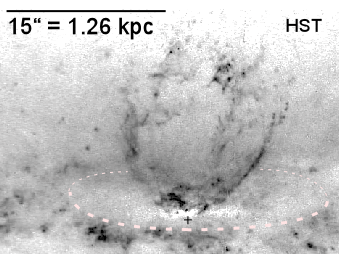
|
Program Overview
We are using HST & Chandra to constrain the energetics of high-velocity gas flows in galaxies.
Such flows can be driven by wide-angle, galactic superwinds from a massive star- or AGN out- burst, or by a collimated particle beam from an AGN.
Best constraints on flow energetics come from systems of ionized filaments because they can
have maximal contrast against unrelated background emission from prosaic processes in the host galaxy. Depending on gas velocities, filaments with quite different density and
temperature — but perhaps comparable pressure — may be proximate, and resolving
displacement can constrain gas dynamics hence the ultimate power source.
Filaments often have uncertain gaseous excitation. Their morphology, hence volume filling fac-
tor h is also uncertain. h scales filament (ionized) masses, hence gas momentum and ener- gies, so must be bound using filter images. We use HST & Chandra to obtain <0.“5 (10 pc)
resolution on nearby systems. Adjacent STIS slit placements map outflow gas motions with the
M-gratings, and UV emission-line fluxes with L-gratings constrain the dominant mechanism that excites gas. We combine these datasets with ground-based, 3D spectra from Fabry-Perot (FP) and Integral Field Spectrometers (IFS). The ground spectra have larger spatial-spectral cover- age to complement our space data. This poster summarizes our work on filamentary outflows in NGC 3079 and NGC 1068; we were supported by grants GO-7353 and GO-01700250 from STScI & SAO.
Tightly Correlated X-ray/Ha Filaments in the Superbubble of NGC 3079 (astro-ph/0205508)
NGC 3079 hosts an AGN and shows much evidence that a powerful superwind has scoured
denser gas and dust from the circum-nuclear region (Cecil et al 2001, ApJ, 555, 338 & refs therein, CBVF hereafter). Chandra now reveals (Fig. 1) a striking match of Ha and soft X-ray
filamentary systems.
With <1800 counts across the 14" (1.2 kpc) diameter superbubble in the available archival
dataset, we limited analysis to single-temperature models. Fig. 2 shows reasonable fits to both the nucleus (kT = 0.55±0.1 keV, ½ solar metal abundance) and superbubble (0.75±0.1 keV, 15% solar metals). The nucleus also shows prominent a Fe complex at 6 keV that signifies an obscured AGN. The soft X-ray gas in the superbubble has thermal and kinetic energies
2x1056 h0.5 & 5x1054h0.5 ergs, respectively.
|